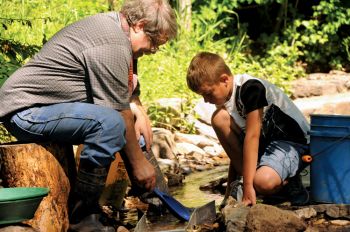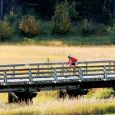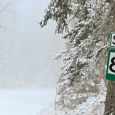The Gift of South Dakota
Subscriptions to South Dakota Magazine make great gifts!
Subscribe today — 1 year (6 issues) is just $29!
Happy Gold Hunter
Mar 21, 2017
We met the miners early on a Sunday morning on Rockerville’s only street. I was hoping they would look like miners because I knew my 8-year-old son Steven had some colorful preconceptions of how our first mining expedition might go.
Steven, a rock hound since the day he was born, wasn’t disappointed. Don Hamm and Gary Mallams weren’t riding mules or carrying shotguns, but the officers of the Black Hills Prospecting Club do look the part of rugged miners.
Off we drove, deep into the pine forest toward Deadman Gulch. Finally, after 10 miles of rugged mountain trails and a hundred questions from Steven, we arrived at the club’s Garnet Claim.
We parked along the trail, grabbed pails, shovels, pans and a pickaxe from Don’s truck, and hiked down into the cool gulch. A clear mountain stream ran on one side of a 10-foot high bank. “Watch for rattlesnakes and mountain lions,” cautioned Gary. Suddenly, Steven wanted to carry the axe.
At the claim, Don and Gary each shoveled a scoop of clay dirt from the bank into 5-gallon buckets. Wearing tall rubber boots, they stepped into the stream, only inches deep but flowing fast, clear and cool.
They began the process of panning — swirling the dirt and minerals around and around — as they told their stories. Gary has been in the Hills for 46 years, but still calls himself a Missouri hillbilly. He worked for the U.S. Forest Service, and then became involved in manufacturing wood furniture parts for the lumber industry. “My regret is that I came here as a young guy and didn’t get involved until 10 years ago,” he told us.
They soon encouraged Steven to help. Gary showed him how to let the water fall away by holding the pan at an angle and swirling slowly. I was anxious that any gold specks might fly out of the pan with the muddy water and gravel. Gary insisted that gold is heavy enough to stay put while mica, the legendary imposter known as fool’s gold, will float away.
Gary said the tools of the mining trade can be expensive for serious prospectors. “My wife said, ‘I thought golf was expensive, until I got into this.’ There’s always a new thing to buy. But we enjoy it. It’s just like fishing or hunting. We’re enjoying the outdoors.”
Panning kits for children and adults new to the hobby can be had for the price of a pizza at outdoor stores in the Black Hills. Kids are not likely to find gold without some help, however, so you may want to consider a guided mining trip at the Big Thunder Mine in Keystone, Black Hills Caverns west of Rapid City or the Broken Boot Mine at Lead. Visit the Clock Shop in downtown Rapid City and take a look at the Icebox Nugget, the largest chunk of Black Hills gold found in the last 120 years.
Don was working with a sluice box in the stream as he told his story. He learned to pan and sluice from his father, Bob Hamm, who grew up working around his father’s steam-powered lumber mill in Deadman Gulch and watching miners working Spring Creek.
Bob — now 92 and still panning — and Don mined 50 ounces of gold in 1982, enough to give them bragging rights as the third largest gold producers in South Dakota for that year. Though they still find gold on their private claim, Don said, “You’re not going to get rich.”
Steven was sorry to hear that, but Gary regained his attention when he said, “Look at that!” He pointed to a flake of bright yellow mineral in the bottom of Steven’s near-empty pan.
"There are a lot of things that look like gold, but gold don’t look like nothing else,” said Gary as he scooped the flake and a bit of water into a vial and gave it to the happiest kid in the gulch.











Comments